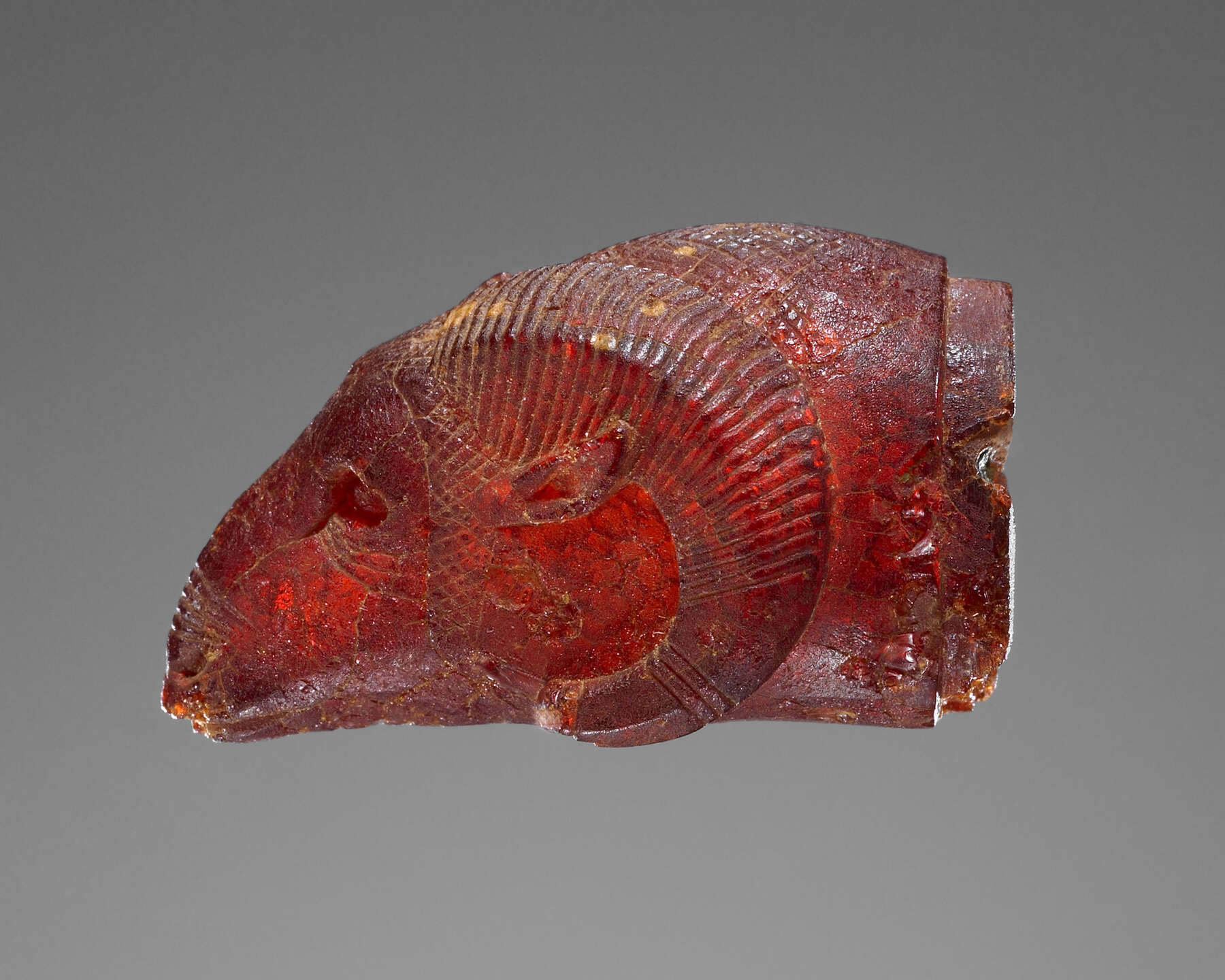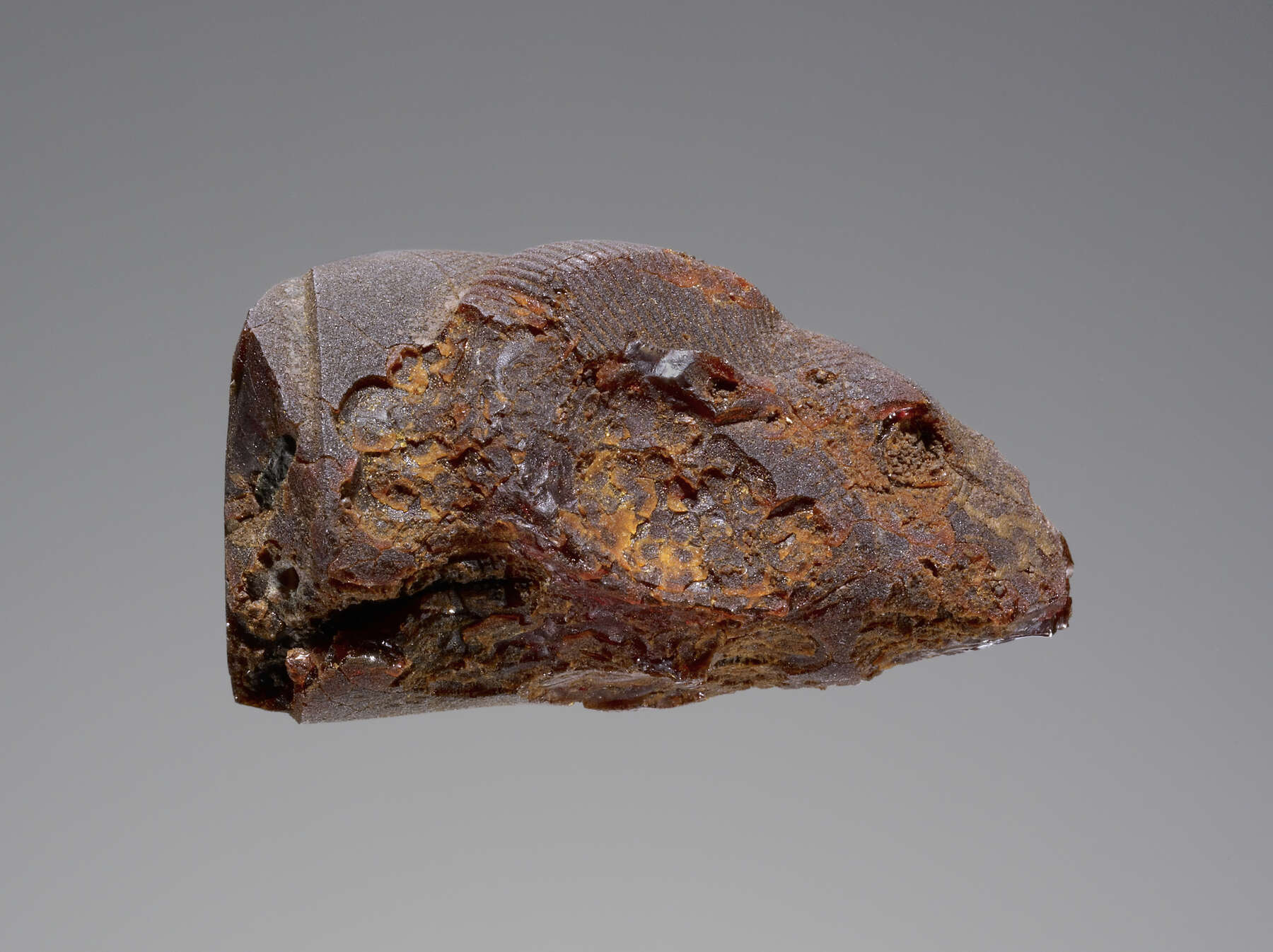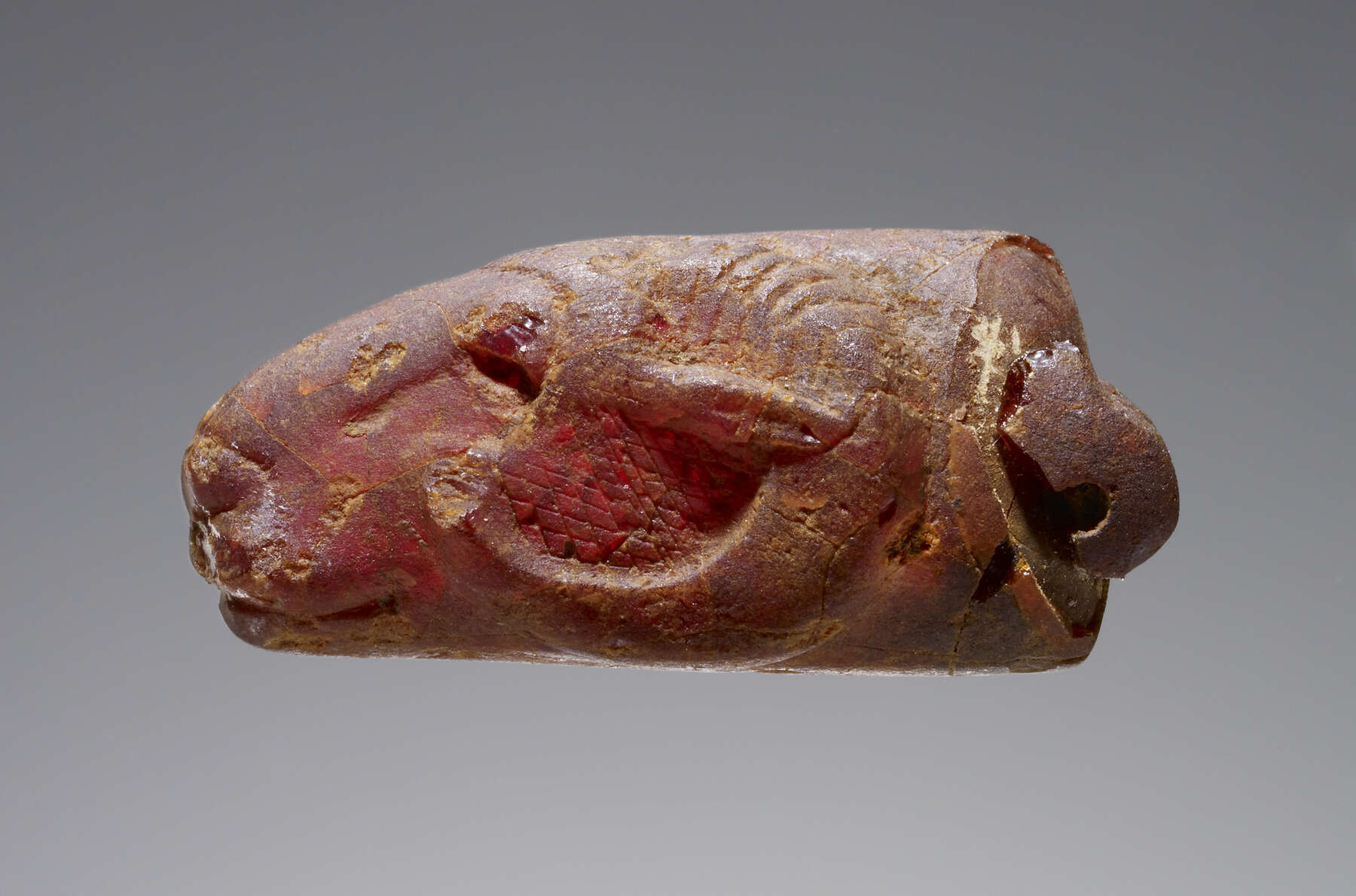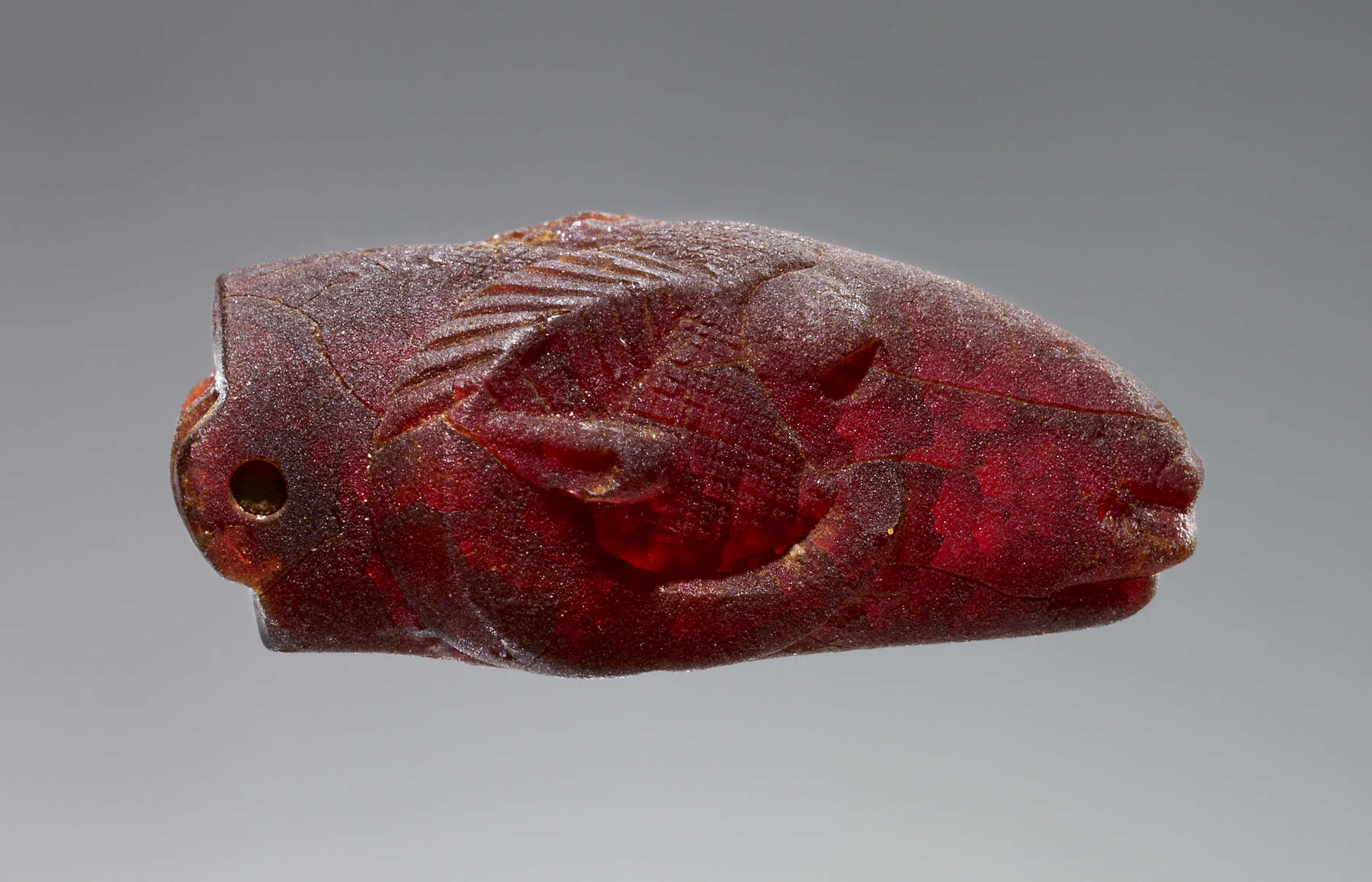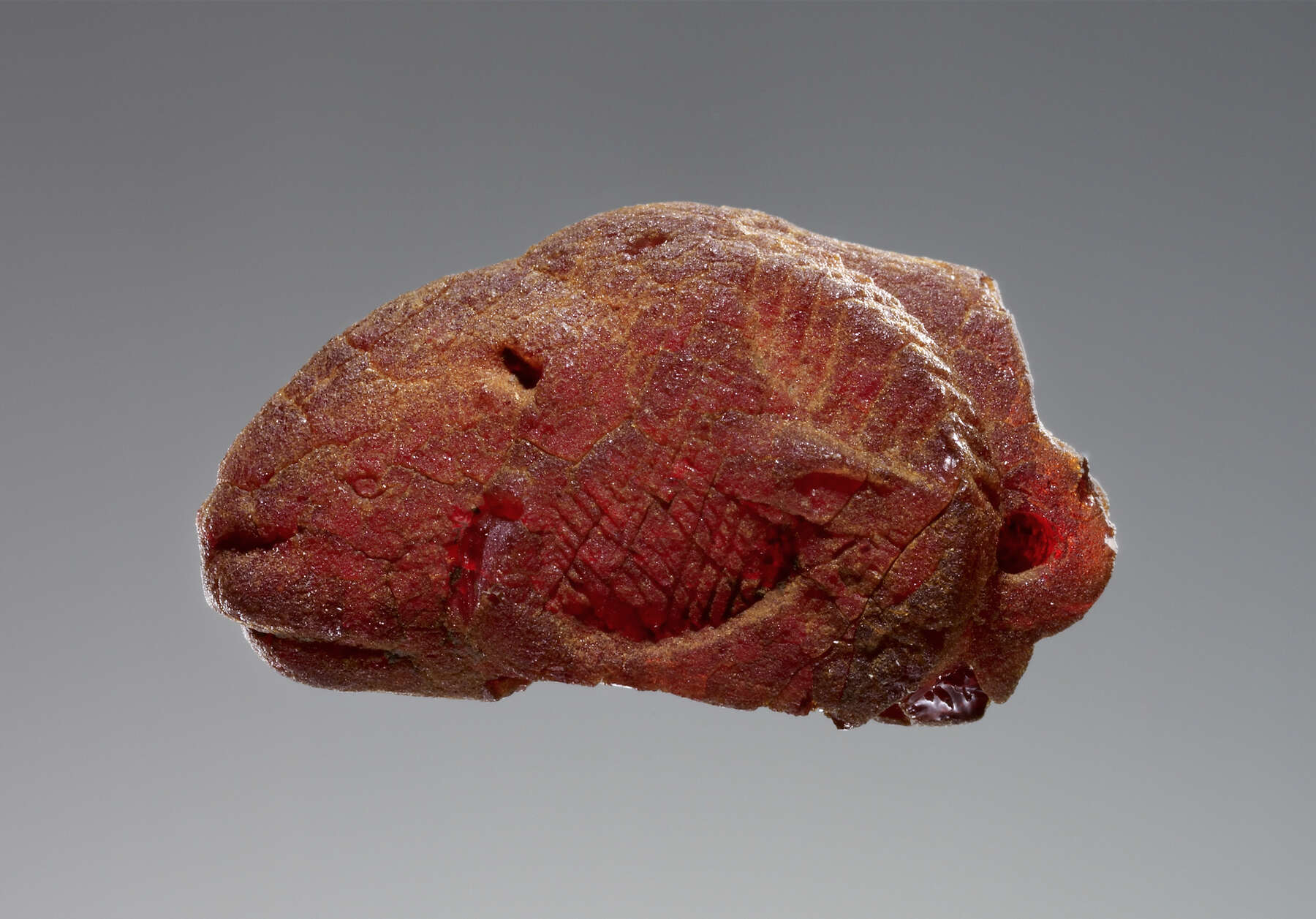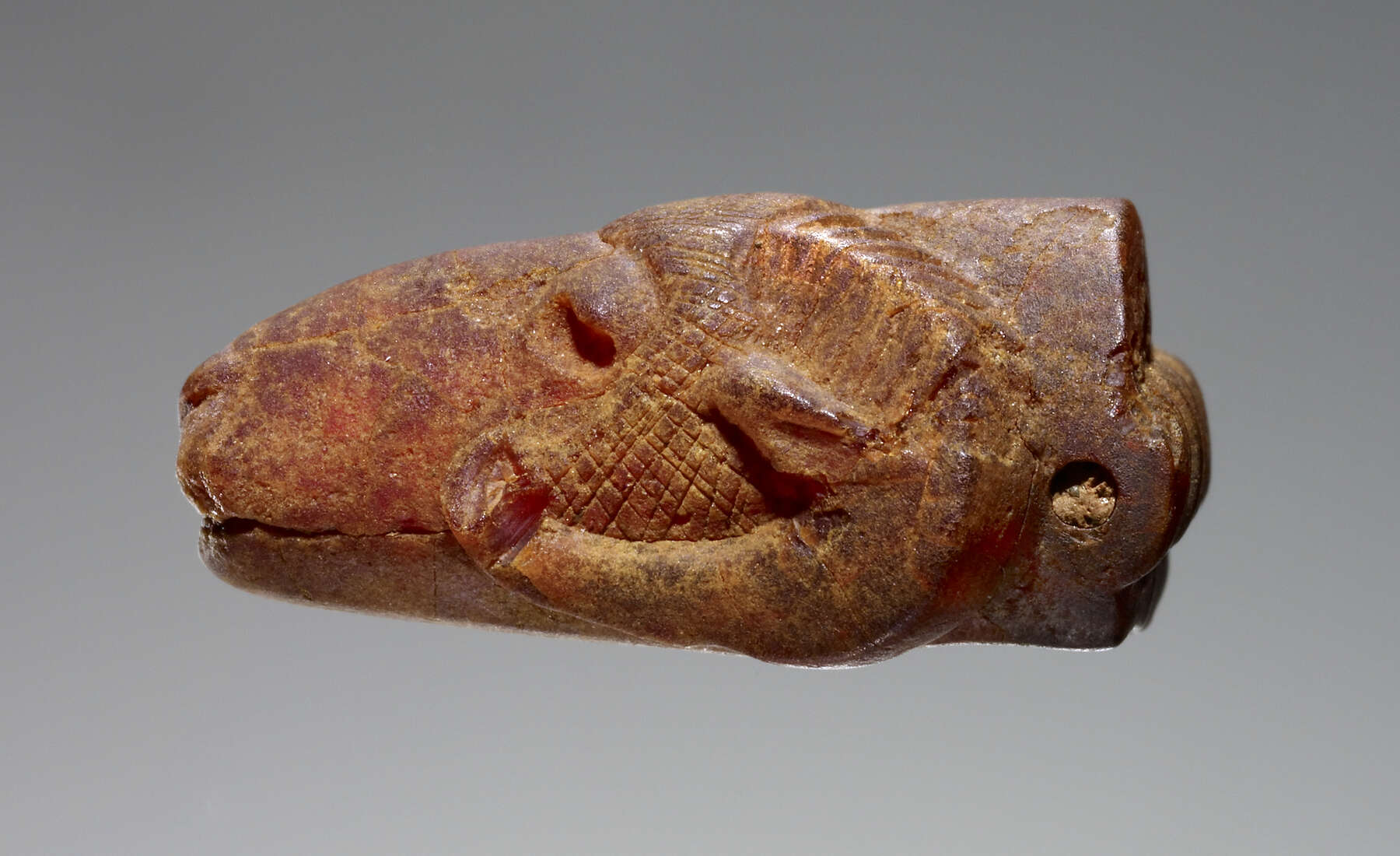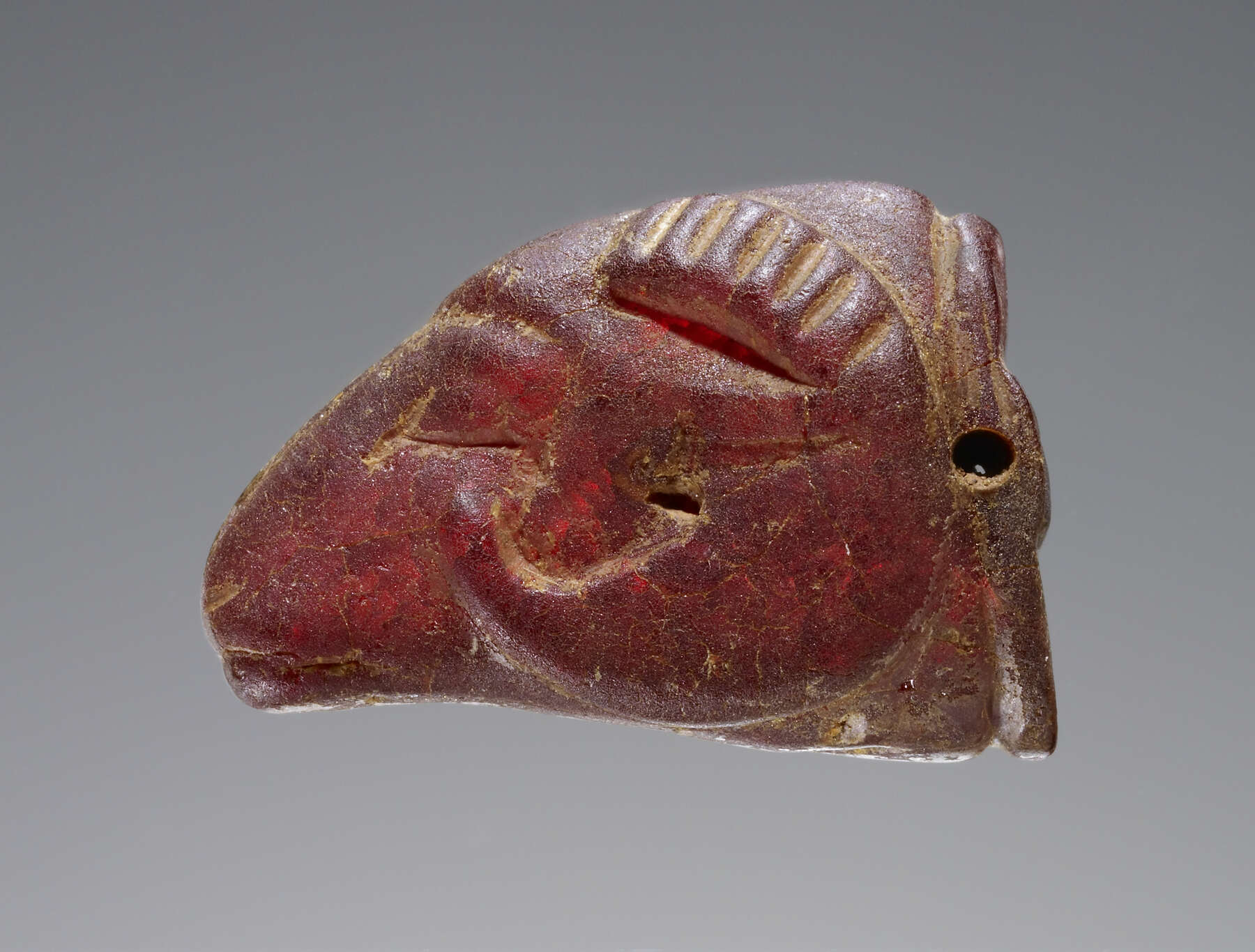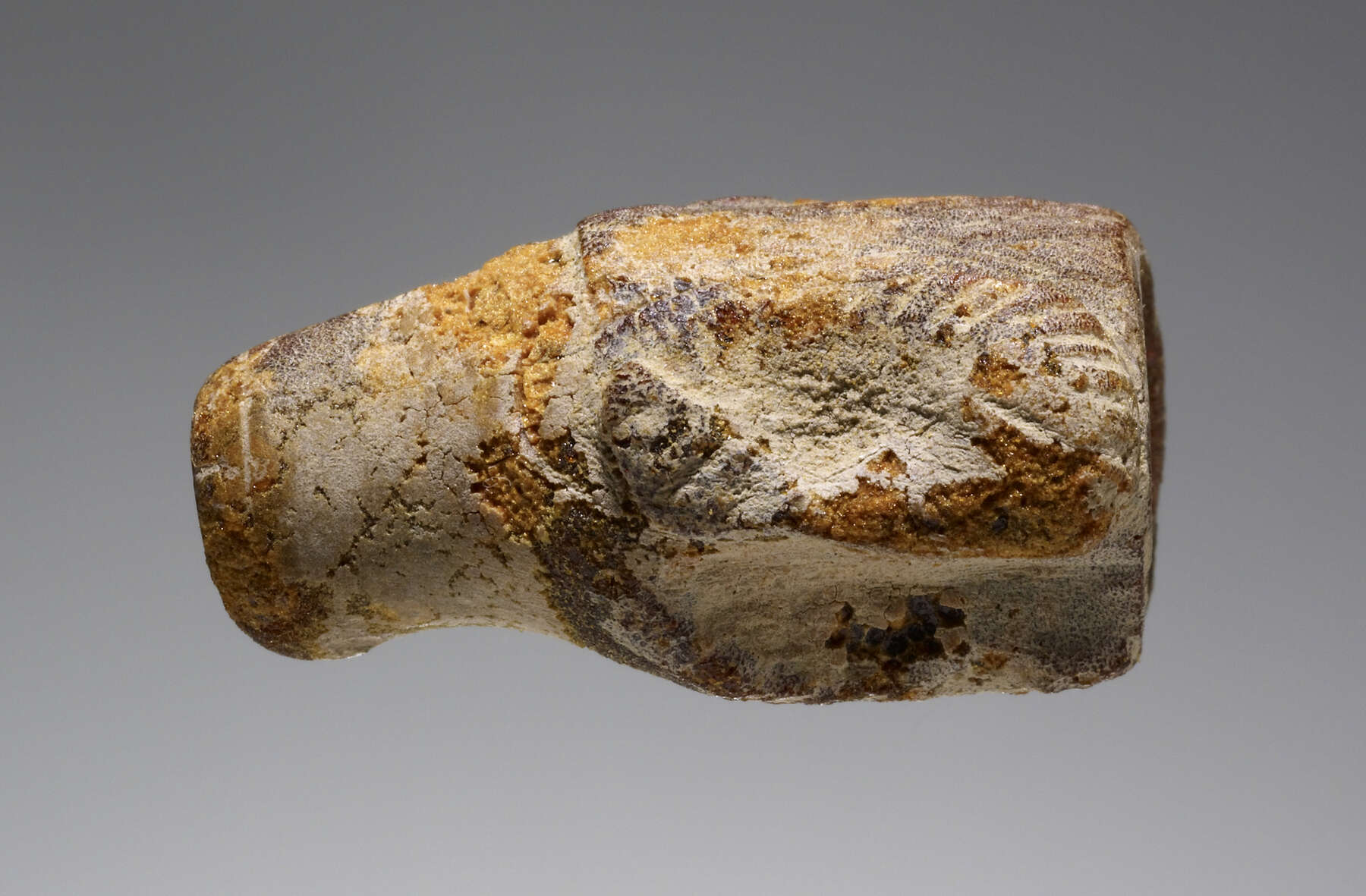The subject of a ram or ram’s head for adornment, amulets, and amuletic jewelry is age-old, and the animal is one of the earliest to appear in these forms. Rams’ heads are among the most numerous of pre-Roman amber subjects and range considerably in style.1 The earliest ones can be dated to the third quarter of the sixth century B.C., but the first documented examples date to the last decade of the sixth. There are a number from fifth-century contexts and a group from the fourth century. Some, such as (cat. no. 39), are minor masterpieces of Archaic art, while others are vaguely blocked out and defined with schematic scratchings. The differences among the rams’ heads throughout the period of their production suggest that they were made by any number of carvers, some highly skilled, others not, for acquirers from all parts of the Italian peninsula and areas within close sailing distance. The findspots include central and south Italy, two sites in ancient Illyria, and Alalia (Corsica). Many others that can be dated by style to the sixth and fifth centuries have come to light without secure documentation. Of the examples in the Getty collection, three are dated here by style to the sixth century, and twelve examples to the fifth.
Amber rams’ heads are usually found in pairs or larger numbers, along with other amber objects—figured and plain pendants, beads, and fibulae. In the sixth century, rams’ heads were the most numerous of all figured subjects in amber. They were joined with korai; female head-pendants; birds; heads of lions, boars, gazelles, and horses; and floral and shell subjects. Ram subjects in amber are not documented in the company of human or humanoid male subjects—satyrs, Dionysos, Herakles, or any of the other unnamed bearded or unbearded males represented in amber. Rare, too, is the interment of ram subjects with demonic subjects. Two exceptions are the rams’ heads from Tomb 102 at Braida di Vaglio, which also included a sphinx, and the rams’ heads in the Petit Palais, Paris, from the Sala Consilina burial, which also included a range of flying figures, perhaps harpies or sirens.2
The parallels for the amber heads in other media have led to the conclusion that the earliest amber rams’ heads were made in the second half of the sixth century, in an ambient where Greek specialists (Laconians, Ionians, Islanders, and other Eastern Greeks) were working, but the locations are elusive. Comparanda for the sixth-century amber rams’ heads include the rams on the handles of Greek bronze vessels, especially Laconian ware, and on other kinds of Greek bronzes—statuettes, mirrors, and other utensils; the sheep subjects engraved on Ionian Greek gems; a singular silver ram pendant in New York; the pairs of rams on a silver East Greek oinochoe found in Lydia; and the rams’ heads struck on coinage from Cyzicus, Cyprus, Lesbos, Delphi, and Melos.3 Plastic vases in the form of recumbent rams and ram protomes, the small plastic ram protomes on Greek and Etruscan ceramics, and the drawings of rams on black- and red-figured vases of various fabrics also provide a mine of further comparanda.
Most of the amber rams’ heads appear to date to the fifth century. Parallels include gold works dated by specialists to the late sixth century, but which may be later. These include a Greek gold ram’s-head pendant from Eretria in Berlin, and a gold fibula with the tip in the form of a ram’s head from Ruvo in London.4 The amber rams’ heads dated to the second half of the fifth century have several good comparisons in precious metals, among them a gold necklace with nine rams’ heads excavated from a tomb of circa 450–425 at Roccanova and the spiral earrings ornamented with rams’ heads worn by the nymph Arethusa on Syracusan tetradrachms of 405 B.C.5
The best evidence for early-fourth-century amber rams’ heads comes from a sporadic find at Cumae and three graves from the Andriuolo necropolis at Paestum, the latter datable to circa 380–370 B.C.6 In each case, rams’ heads were all part of necklaces that also included female heads. Both types are schematic.
An important antecedent for the joining of rams’ heads and other figured elements in jewelry is the “Island Greek” or Lydian (perhaps) crescent-shaped gold pendant from Aydın (Tralles) of about 600 B.C.7 In addition to rams’ heads, this pectoral pendant includes the figure of Potnia Theron with snakes, rosettes, and sun disks, and griffins’, lions’, and bulls’ heads. Potnia Theron is the divinity who oversees plant life, the creatures and demons of the earth, the chthonic realm, and the sky. The Aydın pendant thus might be read as the ontological statement of a divinity of great fecundity and protectiveness. Despite the difference in scale, the role of the ram here is similar to that of the ram protomes of the large stone perirrhanterion, the ritual purification basin, from the Isthmian sanctuary of Poseidon: the bowl is held up by women who stand on lions, holding them by leash and tail, interspersed with large rams’ heads.8 A ritual object such as the seventh-century terracotta lamp from a Gela sanctuary (the rams alternate with female protomes) may be an excerpt of such an ontological declaration.9
Rams’ heads are also a popular subject of “Phoenician” glass pendants10 and the subject of one uncommon type of Egyptian scaraboid, a blue frit amulet of the earlier sixth century made at Naucratis.11 The blue frit scaraboids are unusual in their treatment as seals with representational motifs or inscriptions on the flat sides. Their distribution is significant: Greece, the Black Sea, Magna Graecia (Taranto), and one example from Cerveteri.12 Related Egyptian amulet types, representing the king of the gods, Amun Ra, are the flat-backed amulets of a ram’s head with a disk and uraeus, or uraeus alone, in hollow gold and lapis lazuli as well as glazed-composition and frit, a feature of burials from the Third Intermediate period onward.13 Such is the role of the rams’ heads flanking the necks on the pair of glazed-composition flasks found in the “Isis Tomb” at the Polledrara cemetery at Vulci (British Museum GR 1850.2-27.57): the pair of rams’ heads invoke Amun, and the hieroglyphic inscription expresses greetings for the New Year, a potentially dangerous time of transition, just as was death.
Archaic representations of ram’s-head pendants in use include sculpted and painted examples, worn by both females and males, both deities and mortals. Some examples are telling: the terracotta statuette of an enthroned chthonic(?) female deity from Agrigento wears three superimposed pectoral strings, with bull, ram, and satyr heads.14 The subject of a terracotta urn lid (from the Monte Abatone necropolis, Cerveteri) is a reclining woman who wears a necklace with seven pendants, two of them rams’ heads.15 The male banqueter painted in the pediment of the main wall of the Tomb of Hunting and Fishing at Tarquinia wears three ram pendants on a carrier. In addition, several necklaces (one with three lions’ heads) hang from branches in the grove of the first chamber of the same tomb.16 The rams’ heads (amber) worn by the Monte Abatone figure are painted reddish in color, the same color of the two tiny beads at the top of the necklace, in contrast with the yellow-orange (perhaps gold) central pendants. The three rams’ heads worn by the male banqueter in the Tomb of Hunting and Fishing are the same reddish color as his skin and contrast in color with the yellow- and white-limned vessels (perhaps of shiny bronze or silver) held by the banquet’s participants. The ram’s-head necklace in the first chamber is also painted a reddish color, in contrast with the yellow-orange palmette and lion pendants (also gold, perhaps) in the murals of the first chamber.17
Erika Simon interpreted the trees of the first chamber of the Tomb of Hunting and Fishing as laurels and a sacred grove of Apollo as further evidence supporting her larger argument concerning the importance of Apollo in the funerary art and customs of Etruria (in contrast to his Greek nature).18 If the grove is indeed Apollo’s and the animal-head necklaces hanging from the trees are of amber, this could be taken as further evidence of the connections between amber, Apollo, and life in the tomb as well as the funereal realm. Although the rams’ heads depicted in southern Etruria predate by several decades the Delphic coin types with confronted pairs of mounted rams’ heads (perhaps pendants rather than rhyta), the coins may substantiate the Apollonian connection.19 Alternatively, it is possible that the tomb is Dionysian, as Sybille Haynes argues.20 Stephan Steingräber points out its Dionysian aspects.21
The ram has always enjoyed favor as a potent symbol because of the animal’s legendary strength and virility (and hence its creative powers), and its characteristics as a leader and protector of his flock. In the ancient Near East, and from earliest times throughout the Mediterranean, the ram was associated with powerful divinities and heroic figures, wealth and the elite, and sacrifice. In South Italy, ivory figurines of recumbent animals, including the ram (decorations of fibulae, for the most part), were excavated at Motte delle Timpone (Francavilla Marittima).22 At Argos and Perachora in Greece, ivory ram figurines have appeared in sanctuaries devoted to Hera, and at Ephesus, in that of Artemis. The single greatest number of ivory rams has come from the sanctuary of Ortheia (Artemis Orthia) at Sparta. In each case, the ram is linked with a powerful female divinity and a potent and high-value material. The series of early-sixth-century bronze Laconian hydriai (whose shape might be directly connected with women) with vertical handles animated by female heads, recumbent rams, and lion could be other instances of this affiliation.23 The fourth-century necklaces with rams’ and women’s heads from Paestum, the last gasp of pre-Roman amber carving, may reflect the same pairing.
The traditional importance of the ram’s head as a subject in the ancient Near East is exemplified by two lapis lazuli pendants dating to the third millennium, possibly from Iran, and by a calcite Jemdet-Nasr-period amulet-seal of circa 3000 B.C.24 In Egypt, the ram was connected to several key deities.25 The ram with downturned horns was a symbol of the god Amun, and when he wore the solar disk between his horns or incorporated other solar iconography, the ram’s head was one of two guises of Amun Ra (the other was a goose). A ram’s head in amber, the subject enhanced and focused by the material from which the amulet was made, would put its wearer under the protection of the deity represented and would by assimilation offer the wearer access to its particular powers.26
The ram, the most highly valued and sexually potent of domestic animals, was from earliest times the most prestigious sacrificial victim. Greek drinking vessels (rhyta) in the form of rams’ heads are the most numerous by far and had an ancient ancestry. In Greece, the ram’s-head rhyton, as Hans Hoffman first argued, is associated with tragic heroes (he who must die, i.e., be sacrificed himself).27
A ram’s head might have been worn to show the patronage of, or devotion to, a deity. For a Greek or an Etruscan, a ram’s-head pendant may have been an exotic, “Oriental” magical amulet, a talisman of protection, one that symbolized the power or knowledge of Egypt, the Punic world, or the Near East.
In the Greek-speaking world, the most famous stories of the ram’s apotropaic powers concern acts by Hermes, the Olympian responsible for the increase and protection of flocks. At Tanagra, Hermes averted a pestilence from the city by carrying a ram around its walls. A series of ram-bearer statuettes found at Medma (Calabria) attest to the widespread influence of the cult of Hermes in the West.28 It was Hermes, too, who sent the golden ram that flew Phrixos to safety in Colchis. The magic of the volant ram did not cease at its sacrifice: the Golden Fleece displayed in the grove of Ares was believed to be magical. Throughout Greek culture, the ram figures prominently as a metaphor of strength and courage (thus the association with Ares). Accordingly, Homeric heroes are likened to thick-fleeced lambs (Iliad 3.197). In Attic vase painting, rams are sometimes represented in an explicitly sacrificial context. More commonly, the context is heroic, with the ram’s sacrificial role implicit only. Such is the case in the story of Phrixos, or of Odysseus. Both the ram that carried Odysseus from the Cyclops’s cave (Odyssey 9.436ff.) and Phrixos’s mount are sacrificed as soon as they have finished their tasks. Their sacrifice is part of the story. The emblematic power of the Golden Fleece recalls the story of Atreus and Thyestes: the kingdom belonged to him who owned the golden lamb.
Almost all of the small-scale individual rams’ heads have been found in graves or, in the case of their representation in art, in funerary settings. This is critical to a better understanding of the subject in adornment. Although ram’s-head adornments might be hung from trees in a painting, and worn by both male and female reclining figures, the amber heads from documented contexts have come exclusively from female tombs. It is likely that in each burial, the rams’ heads functioned as ornament and amulet, the subject and material combining to create an elite object, a potent ornament, one with a battery of allusions—religious, divine, heroic, mythic, magical. It may also have worked in aggressive magic or medicine. Many Late Antique gems are engraved with a ram-headed god, one wearing the symbol of the sun (based on Amun Ra), and are specifically connected with the uterus. Such amulets were thought to check any morbid condition, to prevent conception, or to favor and facilitate parturition.29
The solar aspects of amber may well have underscored the connection of the pendant subjects with regeneration, with the Egyptian ba, with solar divinities, with heroes (Odysseus, Phrixos, or Jason), or with a magical figure such as Medea. The Aydın (Tralles) pendant suggests the place of the ram in the universe of a powerful female nature divinity. Of the Olympian gods, if Apollo (the solar divinity) were brought to mind (and to work) by the ram’s head, then perhaps there was an association with his son Phaethon and the Heliades—whose shining tears shed in mourning for their brother Phaethon were hardened by the sun and turned into amber. If Hermes was evoked, it might allude to not only his legendary magical act at Tanagra, but also his role—and the ram’s—as psychopompos. As this survey reflects, the subject of ram imagery in ancient art deserves continued study.30
Notes
- Recumbent and couchant rams of amber are much rarer than rams’ heads. This author knows of only one complete ram from a controlled excavation dating to the fifth century B.C.: a necklace with eighty-four plain beads and a ram pendant from Tomb 21, a collective grave in the cemetery of Valle Oscura (Marianopoli) of circa 530–470 (Marianopoli, Museo Archeologico 925: R. Panvini in , p. 694, no. 44). Ram pendants are among the earliest subjects for amulets and for ornamentation in the ancient Near East. In Greece, bronze ram pendants are current in the Late Geometric: see , p. 148; I. Kilian-Dirlmeier, Anhänger in Griechenland von der mykenischen bis zür spätgeometrischen Zeit (Munich, 1979), pp. 186–88; and C. Rolley, Les statuettes de bronze, vol. 5 of Fouilles de Delphes (Paris, 1969), p. 81, no. 120, pl. 21. ↩
- For Tomb 102 at Braida di Vaglio, see . For the Sala Consilina ambers in the Petit Palais, see introduction, n. 219. ↩
- (esp. chap. 3) has looked closely at the rams of the handles of bronze vessels. Nevertheless, much remains to be done in the analysis of the animals. ↩
- For the Greek gold ram’s head from a necklace (Berlin, Antikensammlung GI 15), see B. Deppert-Lippitz, Griechische Goldschmuck (Mainz, 1985), p. 121, no. 69; for the London gold fibula, , no. 1408; and , pl. 30A. ↩
- For the necklace from Roccanova (Taranto, Museo Archeologico Nazionale 6452–59, 6461–63), , p. 230, VC6. For the Syracusan tetradrachm (a comparison first made by , p. 128), see, for example, E. Boehringer, Die Münzen von Syrakus (Berlin, 1929), no. 423. ↩
- The now-lost tomb contents of a sporadic find from the Cumaean necropolis were recorded in 1913 by E. Gabrici, “Cuma,” 22 (1913): col. 91, fig. 37. At the Paestum necropolis, two rams’ heads were found in the early-fourth-century Tomb 19 (Museo Archeologico Nazionale 24904: , p. 51–52, figs. 18, 1, and 22, 6), three dating to the beginning of the second quarter of the fourth century come from Tomb 22 (21330: ibid., p. 36, figs. 2, 4 and 2, 8), and three from the early third quarter of the fourth century were found in Tomb 20 (24962: ibid., p. 37, figs. 3, 2 and 3, 6). ↩
- Paris, Louvre: 3 (1879): pls. 4–5; and , p. 115. ↩
- Corinth Museum, numerous fragments: M. C. Sturgeon, Isthmia: Excavations by the University of Chicago under the Auspices of the American School of Classical Studies at Athens, vol. 4, Sculpture I: 1952–1967 (Princeton, 1987), no. 1. The sculpted basin, which stood guard over the entrance to Poseidon’s shrine, was for ritual purification. Sturgeon believes that the caryatid female figures represent the Mistress of the Animals and calls her Artemis, considering the lions’ and rams’ heads to reinforce the iconography. (She notes the rarity of rams’ heads in Greek plastic art.) She sees Artemis’s role in this unique object (the only perirrhanterion to have rams’ heads) as that of a protective guardian, or goddess outside the doors. ↩
- Museo Archeologico Regionale di Gela 7711 (from the extraurban sanctuary of Predio Sola, Gela): P. Orlandini, “Gela: La stipe votiva del Predio Sola,” 46, no. 1 (1963): 33–41, figs. 14–16, pls. 8 ac, 9 ab. ↩
- Very few rod-formed glass pendants in the form of a ram’s head are preserved. The type is first found in the seventh century, in a small, not very carefully executed version, and survives down to the first century B.C. The later examples are larger and are rendered more naturalistically. The heads are of white or dark glass, the horns in the opposite color. The animal’s eyes, ears, and horns are various colors. The various kinds of “Phoenician” glass pendants (bearded male heads, demonic heads, rams’ heads, birds, bells, grape bunches, and phalloi) were made the centerpieces of precious metal necklaces throughout the Mediterranean. The few examples from controlled excavations in Italy have come from graves. The rams are attributed to Carthaginian workshops. See , p. 482, no. 758; E. M. Stern and B. Schlick-Nolte, Early Glass of the Ancient World, 1600 BC–AD 50: The Ernesto Wolf Collection (Ostfilden, 1994), pp. 180, 190–91; D. F. Grose, ed., Early Ancient Glass (New York, 1989), pp. 82–83; V. Tatton-Brown, “Rod-Formed Glass Pendants and Beads of the 1st Millennium,” in Greek and Roman Glass, vol. 1, ed. D. B. Harden (London, 1981), pp. 152–53; and M. Seefried, “Glass Core Pendants Found in the Mediterranean Area,” Journal of Glass Studies 21 (1979): 17–26. One seventh-century example from Narce was strung with gold repoussé pendants in the form of winged Hathoric figures: see , no. 1453, pl. 23. The late Catherine Lees Causey was of essential aid with the glass literature. ↩
- A. F. Gorton, “Lions’ and Rams’ Heads,” in , pp. 110–14 (with previous bibl.), believes “the frit rams are undoubtedly the inspiration for the later Greek gold rams’ heads pendant seals, such as the example in London from Kourion.” ↩
- For the Taranto example, see , vol. 2, p. 214, pl. 63.3; and for the Cerveteri seal, ibid., p. 29, no. 98. References are from Gorton 2000 (see n. 11, above). ↩
- , p. 30. See also , p. 445, n. 1219. ↩
- Agrigento, Museo Archeologico Regionale “P. Orso” AG 1145 (from the 1953–55 excavations, sector to the southwest of the sanctuary of the chthonic deities): G. Castellana in , p. 683, no. 96; and E. De Miro, Le Valle dei Templi (Palermo, 1994), p. 59, fig. 61. Strings of boukrania (as several superimposed pectoral ornaments held in place by attachments at the shoulders) are worn by some Archaic female divinities from Magna Graecia. A votive mask phenotype from the extraurban sanctuary of Predio Sola at Gela wears two necklaces, one of taurine heads, the other possibly of acorns: see R. Panvini in , p. 680, no. 93. See also the terracotta seated deities from Athana Lindia. ↩
- Rome, Museo Nazionale Etrusco di Villa Giulia 167: illustrated in , fig. 177. ↩
- See (with earlier bibl.). ↩
- In the banqueting scene of the second chamber, the jewelry worn by the female banqueter and many of the vessels of metallic shapes are painted white or yellow-orange. ↩
- Simon 1973 (see “Lions’ Heads” introduction, n. 22); and E. Simon, “Apollo in Eturia,” Annali della Fondazione per il Museo “Claudio Faina” 5 (1998): 119–48. ↩
- For the Delphi coins with paired rams’ heads (or rhyta, as first identified by C. Seltman, supported by C. M. Kraay), see , p. 121, with reference to C. Seltman, A Book of Greek Coins (London, 1952), p. 14. ↩
- See “Lions’ Heads” introduction, n. 22. ↩
- , p. 95. ↩
- These are among the oldest excavated parallels for recumbent rams on fibulae. ↩
- Ram attachments are found on the upper and lower ends of bronze vessel handles in company with various other subjects. Among them are nude male figures that hold lions by the tail and stand on rams, suggesting a wider interpretation for the subjects. ↩
- One of the lapis lazuli rams’-head pendants is in the Metropolitan Museum of Art (55.65.8), and the other is in the Norbert Schimmel collection, New York; for the latter, see P. O. Harper in , no. 102. For the calcite amulet-seal of a ram’s head, see , no. 103. ↩
- , pp. 15, 30. ↩
- Ny Carlsberg Glyptotek 3571: , pp. 86–88, no. 37 (from which this summary is taken). ↩
- H. Hoffman, Sotades: Symbols of Immortality on Greek Vases (Oxford, 1997), p. 12. ↩
- For the cult of Hermes in Medma, see M. Paoletti, “I culti di Medma,” in Santuari della Magna Grecia in Calabria, exh. cat., ed. E. Lattanzi et al. (Naples, 1996), pp. 95–97. For Medma, see . For a recent collation of bibliography on the kriophoroi of the region and the subject generally, see M. T. Iannelli in , p. 189, no. 30. ↩
- , p. 85. ↩
- Unlike the rich literature on the horse and the lion in ancient art, to my knowledge there is no corresponding analysis of ram imagery. The topic is a rich one, and the in-depth studies of some classes of material, Greek bronze vessel attachments (e.g., ) and Greek vase rhyta (Hoffman 1997, in n. 27, above), lead the way. Research should reveal not only something about artistic approaches to the subject and the transmission and modulation of imagery but also some understanding about ram realia. ↩
Bibliography
- Andrews 1994
- Andrews, C. Amulets of Ancient Egypt. Austin, TX, 1994.
- Magna Graecia 2002
- Bennett, M. J., and A. J. Paul. Magna Graecia: Greek Art from South Italy and Sicily. Exh. cat. Cleveland, 2002.
- Bonner 1950
- Bonner, C. Studies in Magical Amulets, Chiefly Graeco-Egyptian. Ann Arbor, 1950.
- Bottini and Setari 2003
- Bottini, A., and E. Setari. La necropoli italica di Braida di Vaglio in Basilicata: Materiali dallo scavo del 1994. With appendix by M. Torelli. 60, serie miscellanea 7. Rome, 2003.
- Guzzo 1993
- Guzzo, P. G. Oreficerie dalla Magna Grecia: Ornamenti in oro e argento dall’Italia Meridionale tra l’VIII ed il I secolo. Taranto, 1993.
- Hölbl 1979
- Hölbl, G. Beziehungen der ägyptischen Kultur zu Altitalien. 2 vols. Leiden, 1979.
- Haynes 2000
- Haynes, S. Etruscan Civilization: A Cultural History. Los Angeles, 2000.
- Higgins 1980
- Higgins, R. A. Greek and Roman Jewellery. 2nd ed. London, 1980.
- Johansen 1994
- Johansen, F. Greece in the Archaic Period. Cat., Ny Carlsberg Glyptotek. Cophenhagen, 1994.
- Kraay 1976
- Kraay, C. M. Archaic and Classical Greek Coins. London, 1976.
- Langdon 1993
- Langdon, S., ed. From Pasture to Polis: Art in the Age of Homer. Exh. cat. Columbia, MO, 1993.
- Marshall 1911
- Marshall, F. H. Catalogue of the Jewelry, Greek, Etruscan and Roman, in the Departments of Antiquities, British Museum. London, 1911.
- Norbert Schimmel Collection 1974
- Muscarella, O. W. Ancient Art: The Norbert Schimmel Collection. Mainz, 1974.
- Paoletti and Settis 1981
- Paoletti, M., and S. Settis. Medma e il suo territorio: Materiali per una carta archeologica. Bari, 1981.
- Pontrandolfo Greco 1977
- Pontrandolfo Greco, A. “Su alcune tombe pestane: Proposte di una lettura.” Mélanges de l’École française de Rome 89 (1977): 31–98.
- Pugliese Carratelli 1996
- Pugliese Carratelli, G., ed. I Greci in Occidente. Exh. cat. Venice, 1996. Published in English as The Greek World: Art and Civilization in Magna Graecia and Sicily. New York, 1996.
- Steingräber 2006
- Steingräber, S. Abundance of Life: Etruscan Wall Painting from the Geometric Period to the Hellenistic Period. Translated by R. Stockman. Los Angeles, 2006.
- Stibbe 2006
- Stibbe, C. M. Agalmata: Studien zur griechische-archaischen Bronzekunst. Bulletin antieke beschaving supplement. Leuven, 2006.
- Tsetskhladze et al. 2000
- Tsetskhladze, G., A. J. N. W. Prag, and A. M. Snodgrass, eds. Periplous: Papers on Classical Art and Archaeology Presented to Sir John Boardman. London, 2000.
- Uberti 1988
- Uberti, M. L. “Gli avori e gli ossi.” In I Fenici, edited by S. Moscati, pp. 394–403. Exh. cat. Milan, 1988.
- Waarsenburg 1995
- Waarsenburg, D. J. The Northwest Necropolis of Satricum: An Iron Age Cemetery in Latium Vetus. Amsterdam, 1995.
